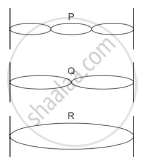Advertisements
Advertisements
प्रश्न
The diagram below shows three different modes of vibration P, Q and R of the same string of a given length.
 |
 |
 |
| P | Q | R |
- Which vibration will produce a louder sound and why?
- Which vibration will produce sound of maximum shrillness (or pitch) and why?
- What is the ratio of wavelength of vibrations P and R?
उत्तर
(a) R will produce maximum sound because it has maximum amplitude.
(b) P will produce maximum shrillness because it has a maximum frequency.
(c) Let's suppose the string has length l
Then wavelength of P = `"2 l"/3`
Wavelength of R = 2 l
∴ `lambda_"P"/lambda_"R" = ("2 l"/3)/"2 l" = 1/3`
∴ λp : λR = 1 : 3
APPEARS IN
संबंधित प्रश्न
What are mechanical waves?
The adjacent diagram shows three different modes of vibrations P, Q and R of the same string.

(i) Which vibration will produce a louder sound and why?
(ii) The sound of which string will have maximum shrillness?
(iii) State the ratio of wavelengths of P and R.
Differentiate between the forced and resonant vibrations.
Why is a loud sound heard at resonance?
When a troop crosses a suspension bridge, the soldiers are asked to break steps. Explain the reason.
(i) Define resonant vibrations.
(ii) Which characteristic of sound, makes it possible to recognize a person by his voice without seeing him?
When acoustic resonance takes place, a loud sound is heard. Why does this happen? Explain.
A vibrating tuning fork is placed over the mouth of a burette filled with water. The tap is opened and the water level gradually falls. It is observed that the sound becomes the loudest for a particular length of the air column. What is the name of the phenomenon taking place when this happens? Why does the sound become the loudest?
